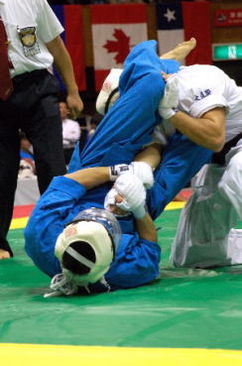- Daido Juku
-
Kudo
(空道)
Kudo Competitor using a submission technique (arm-bar) against opponentAlso known as Kakuto Karate Daidojuku (before 2001) Focus Hybrid Country of origin  Japan
JapanCreator Azuma Takashi Parenthood Kyokushin Karate, Judo
and various martial artsOlympic sport No Official website daidojuku.com Daido Juku (大道塾 Daidō Juku) is the organization for the martial art Kudo (空道 Kūdō), founded in 1981 by Takashi Azuma. Azuma, originally a Kyokushin karate 1977 full contact karate champion, resigned from the Kyokushin organization to form Daido Juku in Sendai city, located in northern Honshū, Japan.
Contents
Style
Daido Juku literally translated means "School of the Great Way". It incorporates techniques which were not present at that time in full contact karate styles. Azuma, being a third-degree black belt in Judo as well as a 4th-degree black belt in Kyokushin karate, recognized the potential for a hybrid martial art. These would not be restricted by the boundaries of a single style but would use techniques from various martial arts, namely, at the time of its creation in 1980, Judo and Karate. In the late 1980s and early 90s the style began to incorporate various techniques from muay thai, boxing, Jujutsu, sambo, submission wrestling, and other martial arts, fine tuning each technique for use within the Daidojuku style. One of the fundamental goals of Daidojuku being the creation of a versatile and realistic fighting style without compromising safety, Azuma created a style which incorporated various offensive as well as defensive techniques which includes punches to the head, elbow strikes, head butts, judo throws, jiu-jitsu jointlocks and other standup and ground fighting techniques.
History
In 1981, Daido Juku made its public debut at the 1981 Hokutoki Karate Championships, also known as Hokutoki. Originally known as Kakuto Karate Daidojuku (格闘空手大道塾 Kakutō Karate Daidōjuku) ("Combat Karate Daidojuku"), the name of the style was changed to recognize its unique and unorthodox techniques as a mixed martial art. In 2001 at an official press conference held for Daido Juku, founder Azuma Takashi and president of Daidojuku, N.P.O., renamed the mixed martial art Budō to Kudo. This renaming allowed Kudo the opportunity of becoming an official Japanese Cultural Budō sport under the same category as Judo, Aikido and Kendo. Kudo and Daido Juku are worldwide copyrights and all of its instructors and branch chiefs are certified under the Kudo International Federation, also known as K.I.F.
Azuma currently holds an 8th degree black belt in Kyokushin Budokai, awarded by Shihan Jon Bluming and an 8th degree black belt in Daidojuku, awarded by the board of directors of Daidojuku.
Equipment
Daido Juku competitors wear an official Kudo Gi gi (sleeves and body of the top gi, like a single-weave judogi, are created out of a single piece of cloth, unlike the traditional karate gi where the sleeves are sewn onto the body). This design of the Kudo gi makes it ideal for throwing and grappling techniques. Also required for competition are groin guard, mouth piece, official Kudo hand-wraps, official Kudo fist protectors and SuperSafe (official Kudo protective helmet). The fist protectors are MMA style gloves which cover the wrist, back of the hand and up to the 2nd joint of the knuckles. The SuperSafe head guard is a unique foam helmet developed by Hanshi Masayuki Hisataka for the Koshiki fighting system practiced by Shorinjiryu karateka to protect a fighter from facial injuries and head trauma. It is this helmet which allows the fighters in Daido Juku to punch and elbow the face, not allowed in more mainstream Kyokushin variants.
This helmet is known outside of Daido Juku circles jokingly as a "space helmet." On a funny note, Azuma Jukucho (founder and president of Daido Juku, also the creator of so called “space helmet”) has been quoted as saying in Japanese: “Call it whatever the hell you want, space helmet, aqua helmet, whatever…this is Kudo, this is Daido Juku.” (Jukucho laughs)
Famous Fighters
- Minoki Ishihara, the karateka who fought Royce Gracie in UFC 2 had previously been a champion in Daido Juku Karate.
- Semmy Schilt won Hokutoki Championship two times (open-weight division, 1996, 1997).
- Yoshinori Nishi, who won Hokutoki Championship in 1984 and 1985 (open-weight division), competed in RINGS, and later founded Wajyutsu Keisyukai, an MMA school that produced Caol Uno and Akira Shoji among others.
- Kenichi Osada, who has participated and won seven years.
- Lee Hasdell, MMA pioneer from England who has fought in K-1, RINGS & Cage Rage.
- Ogawa Hideki, who has participated in all All-Japan championships in -230, always 1st place except one year 2nd place when he tried -240 bracket. Also -230 world champion 2001.
- Shamil Abdulkerimov, Champion of World in Kudo 2009 and 2011 years. Shamil is fighter of M-1 Global.
Publications
- 「はみ出し空手」”Untamed Karate”, 1982
- 「格闘空手」”Combat Karate”, 1983
- 「格闘空手ゼミナール」”Combat Karate Seminar” published in 「空手道」monthly martial arts magazine, 1984
- 「格闘空手への道」”The Way toward Combat Karate”, 1984
- 「格闘空手II」”Combat Karate II”, 1986
- 「格闘空手への道」”The Way toward Combat Karate”, 1989 – Video release
- 「大道無紋」”Daido Mumon”, 1991
External links
Categories:- Organizations established in 1981
- Karate organizations
Wikimedia Foundation. 2010.
